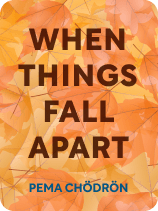

This article is an excerpt from the Shortform book guide to "When Things Fall Apart" by Pema Chödrön. Shortform has the world's best summaries and analyses of books you should be reading.
Like this article? Sign up for a free trial here.
What are the best When Things Fall Apart quotes about compassion and suffering? How can these quotes help you grow as a person?
In When Things Fall Apart, Pema Chödrön argues that pain and suffering are inevitable parts of life. But, these experiences can also be opportunities for growth and transformation.
Keep reading for When Things Fall Apart quotes that express the main ideas of the book.
The 3 Best When Things Fall Apart Quotes
In When Things Fall Apart, Buddhist nun and teacher Pema Chödrön provides guidance on how to find courage and compassion amid pain, loss, and uncertainty. She writes that pain and suffering are inevitable parts of life but that these experiences can also be opportunities for growth and transformation. Drawing on ancient Buddhist wisdom and practices, Chödrön shows us how to cultivate self-awareness and acceptance and face life’s challenges with grace and resilience.
Below we’ll look at three When Things Fall Apart quotes with passages.
“The most fundamental aggression to ourselves, the most fundamental harm we can do to ourselves, is to remain ignorant by not having the courage and the respect to look at ourselves honestly and gently.”
We believe the presence of suffering is unnatural and unacceptable and it signals that there’s something wrong with us and the world. Therefore, we’re convinced that emotional discomfort and pain should be avoided and fixed. Our most overwhelming and painful emotions can feel like personal demons that come in many shapes and sizes—fear, shame, jealousy, rage, loneliness, and the need to place blame.
However, Chödrön explains the Buddhist teaching that suffering is an innate part of life—all living beings on the planet experience pain, loss, confusion, sickness, and death. Emotional discomfort and pain are natural and inevitable, and they aren’t a sign that anything is going wrong. Because we’re not taught to accept suffering and difficult emotions as a natural part of reality, we resist suffering and put tremendous effort into avoiding it, denying it, and trying to fix it. In doing so, we miss out on the beauty and joy of life.
(Shortform note: Many worry that accepting the Buddhist teaching that suffering is a natural part of life will perpetuate suffering. However, in The Art of Happiness, the Dalai Lama and Howard C. Cutler argue that we can’t escape suffering unless we first accept it because ignoring it adds to our suffering (this is similar to Chödrön’s explanation). The Dalai Lama and Cutler add that if we work to accept the inevitability of suffering, we can potentially free ourselves from suffering entirely.)
“We don’t set out to save the world; we set out to wonder how other people are doing and to reflect on how our actions affect other people’s hearts.”
When we suffer, we can get stuck in only caring about protecting ourselves, which leads to isolation and more suffering. But if we can connect our struggles and pain to the struggles and pain of others, we can transform negative experiences into an experience of open-hearted connection and kinship with all life on this planet. Chödrön explains that when our suffering is at its peak, if we deliberately try to feel tenderness for the suffering of other living beings, we can break through our self-absorbed isolation. In this way, compassion can heal us.
(Shortform note: Tara Brach also touches on the common experience of feeling isolated and absorbed in our own concerns when we are suffering and adds an explanation for why this happens. She says when we suffer and are engrossed in our pain, we start to see everyone else as a separate “other.” We do this because painful experiences make us feel unsafe, and it’s our hardwired biological response to look for safety in those most familiar and similar to us while rejecting everyone else. We invent imaginary differences between ourselves and others, labeling them and putting them into boxes, which, in turn, shuts down our ability to feel compassion for their suffering.)
Chödrön teaches that the most powerful way to experience peace and joy is to connect with others in mutual suffering and pain. You can do this through a meditative practice called Tonglen, which means “giving and taking.” In Tonglen, your personal suffering can become a path to compassion.
To practice Tonglen, breathe in and imagine you’re inhaling the suffering of others. Then, breathe out the wish that all beings experience freedom from suffering. You can also practice this by noticing and naming the negative feeling you’re having as you breathe in and breathing out compassion for everyone who’s currently experiencing the same emotion or feeling. For example, if you feel lonely, first acknowledge the feeling to yourself and as you inhale and imagine breathing in the feeling of loneliness. Then as you exhale, breathe out kind and loving thoughts to everyone in the world who also feels lonely in that moment.
(Shortform note: Practicing Tonglen is one way to tap into the compassion for others that Chödrön describes, and Tara Brach offers several other practices to open your heart. She says one useful way of cultivating compassion for others (and ourselves) is simply asking, “What do they need?” Being curious and open to other people’s needs can dissolve feelings of isolation and help you be more loving toward others. You can also practice imagining yourself in other people’s situations to feel how it might feel to be in their situations, which is the essence of compassion. These techniques may be more straightforward ways of being compassionate if the visualization in Tonglen doesn’t work for you.)
“To be fully alive, fully human, and completely awake is to be continually thrown out of the nest. To live fully is to be always in no-man’s-land, to experience each moment as completely new and fresh. To live is to be willing to die over and over again.”
When you stop resisting reality, you can relax and accept whatever is happening in your life and experience more peace, even if your circumstances are painful and stressful.
(Shortform note: Accepting reality as it is doesn’t mean that you resign to or approve of the way things are. Like giving up hope, accepting reality may seem like a counterproductive approach to achieving peace if your reality is difficult, overwhelming, and unjust. However, many leaders in psychology assert that if you don’t accept reality, you waste a lot of mental and emotional effort on resisting it—feeling angry and cheated, for example—that could be used toward cultivating compassion and making positive changes. A common saying in the mental health field is “what you resist persists.”)
Chödrön says to accept reality, you must acknowledge the limited knowledge and control you have in life. In doing so, you can accept the present moment as it is without trying to predict or control the future. Our minds confidently develop inaccurate ideas about ourselves and reality all the time, and we tend to cling to our ideas, even when they’re negative because they provide us with a sense of familiarity and security. However, this sense of security is false, as everything, including ourselves, is in a constant state of change. Chödrön explains that when you accept how little you know about the present and future, you open more to the possibility that your challenging circumstances may have a positive outcome that you can’t yet imagine.
Develop a regular meditation practice and practice mindfulness in your daily life to learn how to stop resisting reality and fighting with yourself and your circumstances. Every time you acknowledge your thoughts, let them go, and return your attention to your breath, you’re strengthening your ability to compassionately accept yourself and reality. Chödrön argues that there is nothing so big or overwhelming that mindfulness and compassion can’t help.

———End of Preview———
Like what you just read? Read the rest of the world's best book summary and analysis of Pema Chödrön's "When Things Fall Apart" at Shortform.
Here's what you'll find in our full When Things Fall Apart summary:
- How to find courage and compassion amid pain, loss, and uncertainty
- How to use pain and suffering to grow and transform your life
- Buddhist methods for easing suffering and finding inner peace






